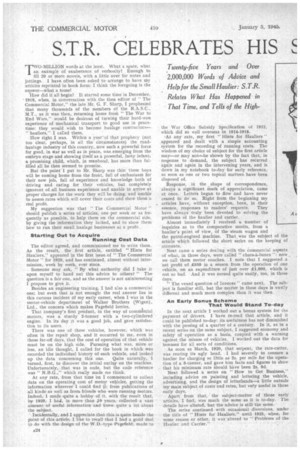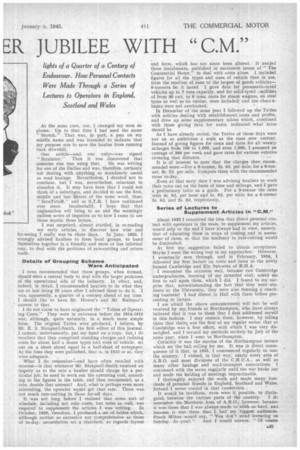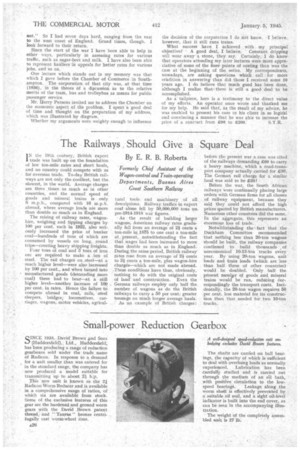S.T.R. CELEBRATES HIS ER JUBILEE WITH "GM."
Page 26

Page 27

Page 28

If you've noticed an error in this article please click here to report it so we can fix it.
TWO-MILLION words at the least. What a spate, what an example of exuberance of verbosity! Enough to fill 20 or more novels, with a little over for notes and jottings. I have, often been asked to arrange to have my articles reprinted in book form: I think the foregoing is the answer—what a tome!
'I-low did it all begin? It started some time in December. 1919, when, in conversation with the then editor of " The Commercial Motor," the late Mr. G. F. Sharp, I prophesied that many thousands of the members of the R.A.S.C., M.T., as it was then, returning home froth " The War to End Wars," would be desirous of turning their hard-won experience of mechanical transport to good use in peacetime: they would wish to become haulage contractors " hauliers," I called them. •
How right I was. Within a year'of th,at prophecy (not too clear, perhaps, in all the circumstances) the roadhaulage industry of this country, now such a powerful force for good, in war as well as in peace, was emerging from the embryo stage and showing itself as a powerful, lusty infant. a promising child, which, in manhood, has more than fulfilled all he then seemed to promise.
But the point 'I put to Mr. Sharp was this: these boys will be coming home from the front, full of enthusiasm for their new job, full of experience and knowledge both of driving and caring for their vehicles, but completely ignorant of all business experience and unable to arrive at proper charges for the work they will be doing, and 'unable to assess rates which will cover their costs and show them a real profit.
My suggestion was that " The Commercial Motor " should publish a series of articles, one per week or as frequently as possible, to help them 'on the commercial side, by giving the information they lacked, and to show them how to run their small haulage businesses at a profit.
Starting Out to Acquire Running Cost Data The editor agreed, and commissioned me to write them. As the result, the first article, entitled " Hints for Hauliers," appeared in the first issue.of " The Commercial Motor " for 1920, and has continued, almost without intermission, week by week, ever since.
Someone may ask, "By what authority did I take it upon myself to hand out this advice to others? " The question is a fair one, and as the answer is not uninteresting' I propose to give it.
Besides an engineering training, I had also a commercial one; but even that is not enough: the real answer lies in this curious incident Of my early career, when I.was in the motor-vehicle department of Walker Brothers (Wigan), Ltd., the concern which makes Pagefield lorries. That company's first product, in the way of comintrcial motors, was a sturdy 2-tonner with a two-cylindered engine. In its day it was a good job, and gave satisfaction to its users.
There was one of these vehicles, however, which was often in the repair shop, and it occurred to me, even in those far-off days. that the cost of operation of that vehicle must be on the high side. Pursuing what was, sabre or less, an idle thought, I called for the book in which was recorded the individual history Of each vehicle, and looked• up the data concerning this one. Quite naturally, I turned, first, to discover the initial outlay on the machine. Unfortunately, that was in code, but the code reference was " N.B.G.," which really made me think.
At any rate, from that time 'on I commenced to collect data on the operating cost of motor vehicles, getting the information wherever I could find it: from publications of all kinds as well as from, friends who were running motors. Indeed, I made quite a hobby of it, with the result that, by 1920, I had, in more than JO years, collected a vast amount of useful information and knew quite a lot about the subject.
Incidentally, and I appreciate that this is quite-beside the point of this article; I like to recallthat I had a good deal to do with the design of the-W.D.-type Pagefreld, made to the War Office Subsidy Specification of 1912, which did so well overseas in 1914-1918.
'At any rate, my first " Hints for Hauliers " appeared and dealt with a simple accounting system for the recording of running costs. The wisdom of my choice of subject for the first article may—or may not-'-be shown by the fact that, in response to demand, the subject has recurred again and again in the intervening years, and is down in my notebook to-day for early reference, so soon as one or two topical matters have been disposed of.
Response, in the shape of correspondence, always a significant mark of appreciation, came at once. Letters began to flow and have never ceased to do so. Right from the beginning my articles have, without exception, been, in their
essence, responses to readers' requests. They have always truly been devoted to solving the problems of the haulier and carrier.
Almost immediately I received a number of inquiries as to the comparative merits, from a haulier's point of view, of the steam wagon and
the petrol-engined machine. That was the subject of the article which followed the short series on the keeping of accounts..
Next came a series dealing with the commercial aspects of what, in those days, were called " chars-a-bancs ": now we call them motor coaches. I note that I suggested a net profit -of £850 in a season from the operation of one vehicle, on an expenditure of just over £1,000, which is not so bad. And it was earned quite easily, too, in those days.
The vexed question of licences " came next. The subject is familiar still, but the.matter in these days is vastly different and much more complex than it was then.
An Early Bonus Scheme That Would Stand To-day
In the next article I worked out a bonus system for the payment of drivers. I have re-read that article, and it could be published to-day: its usefulness has not diminished with the passing of a quarter of a century. In it, as in a recent series on the same subject, I suggested economy and safety of operation as a basis, coupled with a warning against the misuse of vehicles. I worked out the data for bonuses for all sorts of conditions.
As soon as March, 1920, that serpent, the rate-cutter, was rearing its ugly head. I had severely to censure a haulier for charging so little as 2s. per mile for the operation of a 8-tonner, and gave him facts and figures to show that his minimum rate should have been 2s. 9d.
Next followed a series on "How to Get Business," including advice on painting and lettering the vehicle, advertising, and the design of letterheads—a little outside my main subject of costs and rates, but very useful in those early days. Apart from that, the subject-matter of those early articles, I find, was much the same as it is to-day. The details have altered, but the advice is still the same.
The series continued with occasional diversions, under the title of " Hints for Hauliers," until 1925, when, for some reason or other, it was altered to "'Problems of the lIattlier and Carrier." At the same time, too, I changed my now de plume. Up to that time I had used the name " Skotch." That was, in part, a pun on my middle name and was intended to indicate that my purpose was to save the haulier from running back downhill.
One article—and one only—was signed " Scrutator." Then it was discovered that someone else was using that. He was writing for one of the Dailies and was, therefore, certainly not dealing with anything so mundanely useful as road haulage. Nevertheless, I decided not to continue, but I was, nevertheless, reluctant to abandon it. It may have been that I could not think of a substitute, and decided to use the first, middle and last letters of the same word, thus: " ScruTatoR," and • as S.T.R. I have continued ever since. Incidentall§, I hope that that explanation will bring to an end the seemingly endless series of inquiries as to how I came to use those mystic three letters.
I was surprised, almost startled, in re-reading my early articles, to discover how wise and far-seeing I really was in those days. In June, 1920, I strongly advised hauliers to form local groups, to band themselves together in a friendly and more or less informal .way, to deal with the problems of rate-cutting and return loads.
Details of Grouping Scheme Were Anticipated I even recommended that thesegroups, when formed, should elect a central body to deal with the larger prob:ems of the operational side of the industry. In effect, and, indeed, in detail, I recommended hauliers to do what they are at last doing 25 years after I advised them to do it. I was, apparently, a quarter of a century ahead of my time. I should like to have Mr. Howes's and Mr. Rudman's answer to that.
I do not claim to have originated the "Tables of Operating Costs." They were in existence before the 1914-1918 war, although, quite naturally, in a much more simple form. The original Tables were produced, I believe, by Mr. E. S. Shrapnell-Smith, the first editor of this journal. I cannot, unfortunately, put my hand on a-copy, buy do recollect that they comprised standing charges and running costs for about half a dozen types and sizes of vehicle, set out on a sheet about equal to a half-sheet of notepaper. At the time they were published, that is, in 1912 or so, they were adequate.
What I do remember—and have often recalled with interest—is that whenever Mr. Shrapnell-Smith received an inquiry as to the rate a haulier should charge for a particular job, he used to work out the operating cosf, according to the figures in the table, and then recommend, as a rate, double that amount! And, what is perhaps even more interesting, the operator would get that rate. There was not much rate-cutting in those far-off days.
It was not long before I realized that some sort of schedule, including not only costs, but rates as well, was
required to supplement the articles I was writing. In October, 1920, therefore, I produced a set of tables which., although neither so extensive nor comprehensive as those of to-day, nevertheless set a standard, as regards layout
and form, which has not since been altered. It needed three instalments, published in successive issues of " The Commercial Motor," to deal with costs alone. I included figures for all the types and sizes of vehicle then in use, from the smallest of vans td the largest of goods vehicles6-tonners.be it noted. I gave data for pneumatic-tyred vehicles up to 2 tons capacity, and for solid-tyred ,aachines of from 30 cwt. to 6 tons; costs for steam wagons, on steel tyres as well as On rubber, were included; and the chars-abanes were not overlooked.
In December of the same year I followed up the Tables with articles dealing with establishment costs and profits, and drew up some supplementary tables which, combined with those giving data for costs, indicated what -rates should be.
As 'I have already stated, the Tables of those days were not on so ambitious. a scale as the ones now current.
Instead of giving figures for costs and rates for all weekly mileages from 100 to 1,000, and even 1,600, I assumed an average of 300 per week and gave rates for various vehicles
covering that distance. •
It is of interest to note that the charges then recommended were:—For a 3-tonner, 28. 6d. per mile; for a Entonner, 35. 2d. per mile. Compare them with the recommended rates to-day.
Even at that early date I was advising hauliers to work their rates out on the basis of time and mileage, and I gave
a preliminary tab:e as a guide. For a 3-tonner the rates were 4s. 94. per hour agd is. 9d. per mile; for a 6-tonner 5s. 6d, and 2s. 3d. respectively.
Series of Lectures to Supplement Articles In "CM."
About 1932 I conceived the idea that direct personal con7 tact with operators in the mass, to supplement my articles, would nelp to the end I have always had in view, namely, that-of educating them in ways of costing and in assessment of rates, so that the tendency to rate-cutting would be diminished.
At first my, suggestion failed to obtain acceptance. Maybe I went the wrong way in my approaches.However, I eventually won through, and in February, 1934, I delivered 'my first lecture on costs and rates to the neivly formed Cambridge and Ely Sub-area of R.H.A.
I remember .the occasion well, because two Cambridge undergraduates, learning of my intended visit, asked me first to call upon them, which I did. I found to my surprise that, notwithstanding the fact that they were students at the University,' they were also running a coaching busineSsi I had dinner in Hall with them before proceeding to lecture. I am afraid the above announcement will not be well received by. my, friends at Northampton, who have always believed that it was to them that I first addressed myself in this fashion. I may console them, however, by telling them that theirs, was the first of my regular series: that at Cambridge was a first effort, with which I was very dissatisfied, and I revised my methods entirely by July of the same year, when I went to Northampton.
Certainly it was the success of the Northampton lecture which set the ball rolling for me. It was in direct consequence of it that, in 1935, I commenced regularly to tour the country. I visited, in that way, nearly every area of A.12.0. and most divisions of the C.M.U.A., as well as many other haulage and road-transport associations. I continued with the series regularly until the war broke out and made the holding of meetings impracticable.
I thoroughly enjoyed the work and made many hundreds of personal friends in England, 'Scotland and Wales. Ireland I never visited in that connection. .
It would be invidious, even were it possible, to distin guish between the various parts of the country. I .do rememberthe Northern Area of A.R.O., however, because it' was there that I was always made to work so hard, and because it was there that I had• my biggest audiences. Frank Milton would say, " You don't mind lecturing on Sunday, do you? " And• I. would answer, " Of course not." So I had seven days hard, ranging from the east to the west coast of England. Grand times, though. I look forward to their return.
Since, the start of the war I have been able to help in other ways, particularly in assessing rates for various traffic, such as sugar-beet and milk. I have also been able to represent hauliers in appeals for better rates for various jobs, and so on.
One lecture which stands out in my memory was that which I gave before the Chamber of Commerce in Southampton. The corporation. of that city was, .at that time (1936), in the throes of a discussion as to the relative merits of the tram, bus and trolleybus as means for public passenger service.
Mr. Ilarry Parsons invited me to address the Chamber on the economic aspect of the problem. I spent "a good deal of time and thought on the preparation of my address, which was illustrated by diagram.
Whether my arguments were weighty enough to influence the decision of the corporation I do not know. I believe, however, that it still runs trams.
What success have I achieved with my principal objective? A good deal, I believe. Constant dripping will wear away' a stone, they say. Certainly, I do know that operators attending my later lectures were more appre • dative of some of the finer points of costing than was the case at the beginning of the series. My correspondents, nowadays, are asking questions which call for more erudition in answering than did those I received some 10 years ago. I do believe that much good has been done, although I realize thatthere is still a good deal to be accomplished.
As a tailpiece, here is a testimony to the direct value of my efforts. An operator, once wrote and thanked me for my help. He said that, as the result of my advice, he was enab:ed to present his case to his client in so logial and convincing a manner that he was able to increase the
price of a contract from £90 to £200, S.T.R.




















































